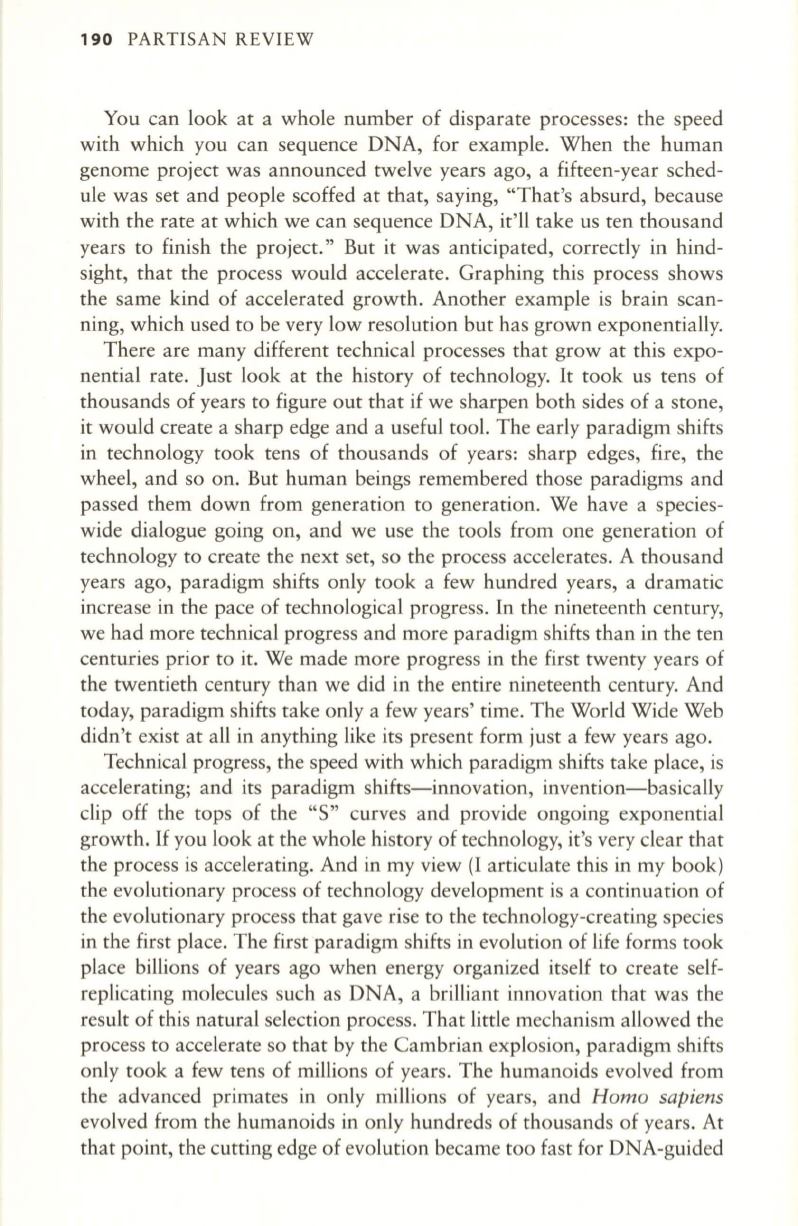
190
PARTISAN REVIEW
You can look at a whole number of disparate processes: the speed
with which you can sequence DNA, for example. When the human
genome project was announced twelve years ago, a fifteen-year sched–
ule was set and people scoffed at that, saying, "That's absurd, because
with the rate at which we can sequence DNA, it'll take us ten thousand
years to finish the project." But it was anticipated, correctly in hind–
sight, that the process would accelerate. Graphing this process shows
the same kind of accelerated growth. Another example is brain scan–
ning, which used to be very low resolution but has grown exponentially.
There are many different technical processes that grow at this expo–
nential rate. Just look at the history of technology.
It
took us tens of
thousands of years to figure out that if we sharpen both sides of a stone,
it would create a sharp edge and a useful tool. The early paradigm shifts
in technology took tens of thousands of years: sharp edges, fire, the
wheel, and so on. But human beings remembered those paradigms and
passed them down from generation to generation. We have a species–
wide dialogue going on, and we use the tools from one generation of
technology to create the next set, so the process accelerates. A thousand
years ago, paradigm shifts only took a few hundred years, a dramatic
increase in the pace of technological progress. In the nineteenth century,
we had more technical progress and more paradigm shifts than in the ten
centuries prior to it. We made more progress in the first twenty years of
the twentieth century than we did in the entire nineteenth century. And
today, paradigm shifts take only a few years' time. The World Wide Web
didn't exist at all in anything like its present form just a few years ago.
Technical progress, the speed with which paradigm shifts take place, is
accelerating; and its paradigm shifts-innovation, invention-basically
clip off the tops of the "5" curves and provide ongoing exponential
growth.
If
you look at the whole history of technology, it's very clear that
the process is accelerating. And in my view (I articulate this in my book)
the evolutionary process of technology development is a continuation of
the evolutionary process that gave rise to the technology-creating species
in the first place. The first paradigm shifts in evolution of life forms took
place billions of years ago when energy organized itself to create self–
replicating molecules such as DNA, a brilliant innovation that was the
result of this natural selection process. That little mechanism allowed the
process to accelerate so that by the Cambrian explosion, paradigm shifts
only took a few tens of millions of years. The humanoids evolved from
the advanced primates in only millions of years, and
Homo sapiens
evolved from the humanoids in only hundreds of thousands of years. At
that point, the cutting edge of evolution became too fast for DNA-guided


